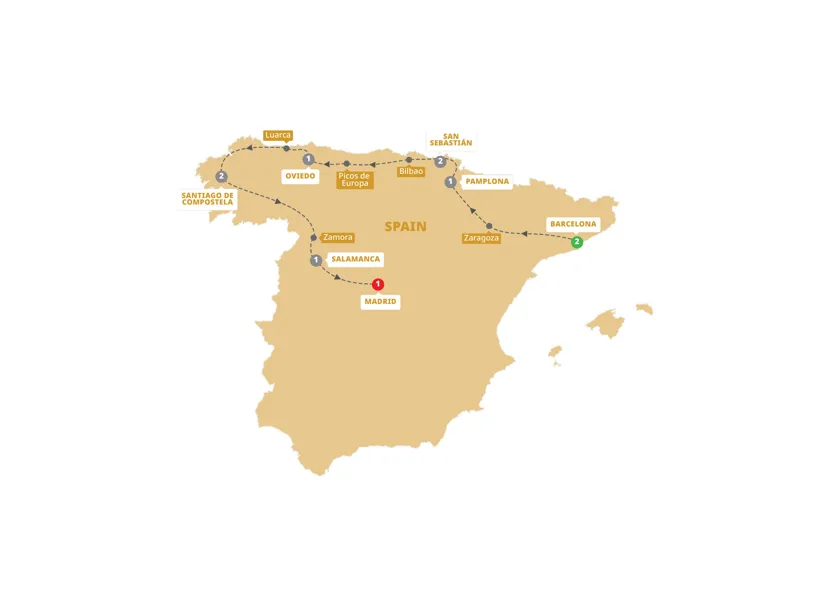No Spanish adventure is complete without sampling the local paella. Visit Spain and sample local varieties paired with the perfect Spanish wines.
Paella: Origins, Variations,
Wine Pairings, and Recipe

No Spanish adventure is complete without sampling the local paella. Traditionally, paella is a mixture of chicken or rabbit (or both), beans, rice, and other vegetables. Though, if you're heading to a coastal town, you'll often find variations with calamari, mussels, clams, prawns, scampi, or fish. No matter where you enjoy the dish, or which variation is served, you're pretty much guaranteed an incredible culinary experience.
What Is Paella?
The iconic Spanish dish may vary by region. The original paella, Paella Valenciana, is traditionally made with rabbit and snails, butter beans, round-grain white rice, rosemary, saffron – channeling the country's Moorish ancestry – and, of course, wine. You won't find paella like this anywhere else, and Valencians regard their paella as one of the city's identifying symbols. In other regions, paella is a mix of fresh Mediterranean seafood, local game, citrus, and a variety of vegetables.

How Do You Say Paella?
Typically, the word is pronounced pah/EH/yah. You might also hear it pronounced like pie/EH/ah, but stick with the "pah" and always put the emphasis on the second syllable. In terms of etymology, the word "paella" may take its name from the Latin term patella, a flat plate on which offerings were made to the gods.
A Brief History of Paella
The dish was initially created by rice farmers who lived near Lake Albufera in Valencia in the 15th century. Arabic Moors bought rice and saffron to the Iberian Peninsula in the 800s, and Valencia was (and still is) one of the most significant rice-producing regions in Spain. Rice farmers cooked what they could forage from the rice fields for their lunch, including plump tomatoes, sweet onions, beans, occasionally snails, and, of course, rice. The dish began as a tasty meal put together from fresh, at-hand ingredients that could be shared among many. As love for the dish grew, so did the varietal ingredients.
Regardless of what you may hear from purists when sampling paella in different regions, it's important to remember that the dish epitomizes a true blend of local fare and foreign flavors, a mix of traditional and new.
Paella Variations
Traditional Paella Valenciana
The classic version is made with rabbit, chicken, butter beans, long beans, snails, rosemary, and saffron. Served with bread and wine. Always with wine.
Paella de Marisco (Seafood Paella)
A seafood version with no meat, typical of Spain's coastal regions. This version usually has peas prawns, mussels, calamari, and clams and is served with lemons or limes.
Paella Negra (Black Paella)
A brinier cousin to Marisco, this one is a fantastic Spanish favorite and one you have to try if you see it on the menu. You'll recognize it by its black rice made with squid ink.
Mixta Paella (Mixed Paella)
You guessed it! This version takes the best of everything and mixes Valencian and Marisco with meat and seafood. It's the most popular of all.
Paella Vegetariana (Vegetarian Paella)
You'll often find a vegetarian option offered. Expect to be surprised and delighted each time by a variety of vegetables, including lemon artichokes, lima beans, or red and greens peppers. You might even find chickpeas and potatoes too.
Paella Socarrat - Why Is It So Important?
Socarrat, often referred to as "Valencian caviar," is the layer of crispy toasted rice that only develops at the bottom of the pan when the paella is cooked perfectly. It takes skill and constant stirring throughout the preparation, plus an increase in heat just before serving. As it offers all of the delicious flavors in a concentrated and nutty toasted bite, most connoisseurs of the dish consider it the best part. Paella without the bites of socarrat crunchy goodness just isn't paella.
Pairing Wine With Paella
Of course, it wouldn't be a Spanish meal without a healthy amount of vino at hand. A meal of paella is typically prepared in a large pan and served in the same pan, placed in the center of the table as a family-style meal surrounded by bread and a couple of bottles of local wine. If sipping in Valencia, you might not hesitate to pair red wine with the traditional rabbit in the dish. Though, for some, it may be off-putting to think of pairing a red with a fresh seafood variation. In the end, you're going to have to trust us…
Wine Pairings for Paella Valenciana
Even Paella Valenciana has its local variations, so flavors can vary depending on where you are in the city. However, you can't go wrong with a Tempranillo from the Ribera del Duero region. Ribera del Duero wines are usually entirely Tempranillo, rather than a blend, and offer lightly spiced and earthy flavors that pair wonderfully with the game meats of Paella Valenciana. If you prefer white wines, go for a white wine made from Verdejo. These bold whites are wonderfully aromatic, with light hints of lemon and almond. Want to learn more about Spanish wines? Check out this article on Our Top Spain Wine Regions and find your favorite!
Wine Pairings for Paella de Marisco & Paella Negra
For paellas with seafood, you're in luck, as Spain offers outstanding light red wines and perfectly crisp whites to pair with the fresh flavors and citrus fruits that accompany the dish. You're going to want to look for a light, cold wine produced in a coastal region that won't dominate the delicate balance of the dish. For a white, our top choice would be an Albariño, a beautiful wine with hints of brine, white flowers, and stone fruit that makes a perfect pairing for seafood. If you're up for a red wine, go for a well-chilled Garnacha (Grenache), again from a coastal region. You'll find that these offer a lovely blend of acidity and fruit that won't overpower your meal.
Wine Pairings for Mixta Paella & Paella Vegetariana
The world is your oyster (ahem, mussel) when ordering a wine to pair with a mixed or vegetarian paella. Stick with what you like, but definitely order a bottle or two.

Customizable Paella Recipe
Paella is totally customizable so feel free to make this dish vegetarian, all seafood, or all meats.
Prep Time
15 mins
Cook Time
45 mins
Total Time
1 hr
Ingredients for Paella (Customizable)
1/2 tsp saffron lightly crushed
1/4 cup oil
2 links Spanish chorizo sliced
4 bone-in, skin-on chicken thighs (or rabbit, if you can source it)
10-12 large shrimp or prawns peeled and deveined
1 small onion minced, about 1 cup
3 cloves garlic crushed
2 cups medium tomatoes diced
1 tbsp smoked paprika
6 cups chicken broth
2.5 cups round-grain rice
1 red or orange pepper sliced into 1" strips
Peas
If making vegetarian, add artichoke hearts, beans, etc. as well
12 mussels or clams
How to Make Paella
Lightly crush the saffron and soak it in a small bowl with 1/4 cup hot water, then set aside for 15 minutes.
Give your proteins a quick sear in olive oil in your paella pan over medium-high heat. Cook chicken skin-side down and brown any pork, sausage, or chorizo. Don't overcook your shrimp, just flip until just browned for about 5 minutes. Then transfer it to a plate, leaving the meats to sear in the pan.
Add onions, garlic, tomatoes, and paprika and cook, stirring frequently, until the onions are soft, opaque, and fragrant. About 5-6 minutes
Flip the chicken and add 4 cups of the chicken stock and the saffron water and bring everything to a boil.
Add the rice slowly to create a thin layer, using a spoon to evenly distribute. Add peppers, if using, and bring the liquid back to a simmer and cook, uncovered until the rice absorbs almost all the liquid. Cook, uncovered, without stirring, until the rice has absorbed most of the liquid, but once the stock is low enough, add the remaining 2 cups chicken stock. Should take about 12-15 minutes.
Add peas, artichokes, beans, misc. veggies, and any seafood. Rest the shrimp or prawns on top and push mussels or clams below the surface, with the opening of the shell facing up.
Continue to cook on low until the shells open up and the rice is almost cooked through.
Right as the rice is al dente, turn the heat up to high for 1-2 minutes to create the socarrat - the best part, that crispy toasty crunchy rice crust.
Remove the pan from heat, cover, and let sit for five minutes before serving. Enjoy!





















